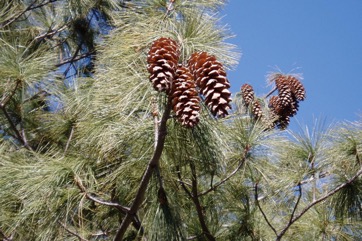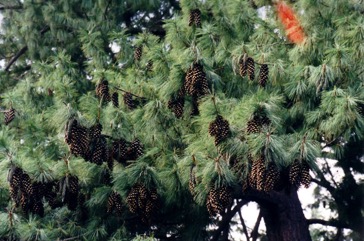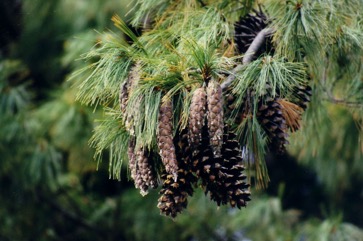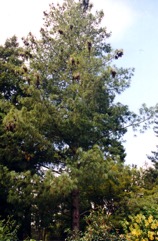Himalayan blue pine, Bhutan pine, Blue Pine, Himalayan Pine, Qiao song, Kail, Yiro, Kaiar, Lim, Raisalla, Lamshing, Byans, Cheel, Dolchilla, Neet-kung, Tongschi, Lamshing

It is a temperate plant. It is frost hardy. In China it grows in the mountains in the temperate rainforests between 1600-3300 m altitude in Yunnan. It suits hardiness zones 6-9. Arboretum Tasmania. Hobart Botanical Gardens, Launceston city Park, Kyneton Botanical Gardens.
Also known as:
Cheeltu, Himalajski bor, Nashtar
Synonyms
- Pinus excelsa Wallich ex D.Don (1828) not Lamarck(1778)
- Pinus griffithii M'Clelland (1854) not (J.D.Hooker) Parlatore (1868)
- Pinus nepalensis Chambray (1845) not J.Forbes (1839)
Edible Portion
- Seeds, Sap, Manna, Stem
Where does Himalayan blue pine grow?
Found in: Afghanistan, Africa, Asia, Australia, Bhutan, Britain, China, France, Germany, Himalayas, India, Indochina, Italy, Kashmir, Myanmar, Nepal, Northeastern India, Pakistan, Romania, SE Asia, Sikkim, Slovenia, South Africa, Tasmania, Tibet, Ukraine, United States, Yugoslavia
Notes: There are over 100 species of Pinus.
Status: The seeds are especially eaten by children.
Growing Himalayan blue pine, Bhutan pine, Blue Pine, Himalayan Pine, Qiao song, Kail, Yiro, Kaiar, Lim, Raisalla, Lamshing, Byans, Cheel, Dolchilla, Neet-kung, Tongschi, Lamshing
Edible Uses: A sappy exudate from the leaves and twigs hardens and is eaten. It is also added to honey. The tender layer of the stem just beneath the bark is edible. The seeds are sometimes eaten.
Production: Cones take 18 months to mature. In NW Pakistan seeds are collected in October.
Nutrition Info
per 100g edible portion| Edible Part | Energy (kcal) | Protein (g) | Iron (mg) | Vitamin A (ug) | Vitamin c (mg) | Zinc (mg) | % Water |
|---|---|---|---|---|---|---|---|
| - | - | - | - | - | - |
Himalayan blue pine, Bhutan pine, Blue Pine, Himalayan Pine, Qiao song, Kail, Yiro, Kaiar, Lim, Raisalla, Lamshing, Byans, Cheel, Dolchilla, Neet-kung, Tongschi, Lamshing Photos




References
Ambasta, S.P. (Ed.), 2000, The Useful Plants of India. CSIR India. p 459
Bull. Misc. Inform. Kew 1938:85. 1938
Coombes, A.J., 2000, Trees. Dorling Kindersley Handbooks. p 75
Cundall, P., (ed.), 2004, Gardening Australia: flora: the gardener's bible. ABC Books. p 1051
Facciola, S., 1998, Cornucopia 2: a Source Book of Edible Plants. Kampong Publications, p 171
Fu Liguo, Li Nan, Mill, R.R., Pinaceae. Flora of China.
Harris, E & J., 1983, Field Guide to the Trees and Shrubs of Britain. Reader's Digest. p 257
Hedrick, U.P., 1919, (Ed.), Sturtevant's edible plants of the world. p 320, 497 (As Pinus excelsa)
Hibbert, M., 2002, The Aussie Plant Finder 2002, Florilegium. p 234
http://www.botanic-gardens-ljubljana.com/en/plants
Joyce, D., 1998, The Garden Plant Selector. Ryland, Peters and Small. p 172
Lord, E.E., & Willis, J.H., 1999, Shrubs and Trees for Australian gardens. Lothian. p 88
Plants for a Future database, The Field, Penpol, Lostwithiel, Cornwall, PL22 0NG, UK. http://www.scs.leeds.ac.uk/pfaf/
Ryan, S., 2008, Dicksonia. Rare Plants Manual. Hyland House. p 69
Sahni, K.C., 2000, The Book of Indian Trees. Bombay Natural History Society. Oxford. p 198
Tanaka,
Thakur, D., et al, 2017, Why they eat, what they eat: patterns of wild edible plants consumption in a tribal area of Western Himalaya. Journal of Ethnobiology and Ethnomedicine (2017) 13:70
Tsering, J., et al, 2017, Ethnobotanical appraisal on wild edible plants used by the Monpa community of Arunchal Pradesh. Indian Journal of Traditional Knowledge. Vol 16(4), October 2017, pp 626-637
www.worldagroforestrycentre.org/treedb/